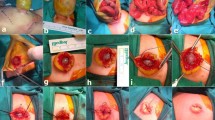Abstract
Background
The anatomy and clinical significance of obliterated umbilical artery called as medial umbilical ligament (MUL) have not been documented well in literature. In this study, we investigated anatomical variations of MUL determined by laparoscopic exploration of abdomen in children and anatomy dissection on cadaver.
Patients and methods
The anatomy of MUL was investigated in a total of 126 patients including 41 retrospective cases. All 126 patients had laparoscopic exploration for a lower abdominal pathology. In retrospective group, videos demonstrating clearly both MULs and the region during laparoscopic exploration were selected. A dissection on an adult male cadaver was also performed. A preliminary grading scale of anatomical appearance of MUL was obtained.
Results
In grade 0, patients had no visible ligament (n = 14); in grade 1, MUL was a fibrous cord without a web formation (n = 63); in grade 2, MUL was a fibrous cord with a web (n = 49). MULs on both sides of the lower abdominal wall were symmetrical in all cases except one having a cloacal anomaly. This case had a solitary MUL on the right side.
Conclusions
A MUL with a fibrous cord and significant web may cause technical difficulties and narrow the working space in laparoscopic exploration of children. It may also affect the surgeon’s preference on trocar locations. In all grades of anatomical variation of MUL, formation of the ligament on both sides of the lower abdominal wall is similar. If there is a single umbilical artery, it becomes a solitary MUL after birth, and the possibility of associated malformations, especially urogenital abnormalities increases in such cases.




Similar content being viewed by others
References
Little DC, Shah SR, St Peter SD et al (2005) Urachal anomalies in children: the vanishing relevance of the preoperative voiding cystourethrogram. J Pediatr Surg 40:1874–1876
O’Malley KJ, Monkhouse WS, Qureshi MA, Bouchier-Hayes DJ (1997) Anatomy of the peritoneal aspect of the deep inguinal ring: implications for laparoscopic inguinal herniorrhaphy. Clin Anat 10:313–317
Joó JG, Beke A, Papp Z, Rigó J, Papp C (2008) Single umbilical artery in fetopathological investigations. Pathol Res Pract 204:831–836
Martínez-Frías ML, Bermejo E, Rodríguez-Pinilla E, Prieto D, ECEMC Working Group (2008) Does single umbilical artery (SUA) predict any type of congenital defect? Clinical-epidemiological analysis of a large consecutive series of malformed infants. Am J Med Genet A 146:15–25
Nezhat CH, Nezhat F, Brill AI, Nezhat C (1999) Normal variations of abdominal and pelvic anatomy evaluated at laparoscopy. Obstet Gynecol 94:238–242
Frede T, Stock C, Rassweiler JJ, Alken P (2000) Retroperitoneoscopic and laparoscopic suturing: tips and strategies for improving efficiency. J Endourol 14:905–913
Author information
Authors and Affiliations
Corresponding author
Rights and permissions
About this article
Cite this article
Tokar, B., Yucel, F. Anatomical variations of medial umbilical ligament: clinical significance in laparoscopic exploration of children. Pediatr Surg Int 25, 1077–1080 (2009). https://doi.org/10.1007/s00383-009-2467-y
Accepted:
Published:
Issue Date:
DOI: https://doi.org/10.1007/s00383-009-2467-y




